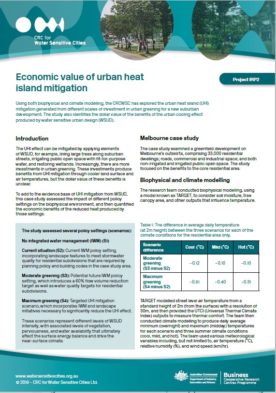Economic value of urban heat island (UHI) mitigation: a case study
Introduction
The UHI effect can be mitigated by applying elements of WSUD, for example, lining large trees along suburban streets, irrigating public open space with fit-for-purpose water, and restoring wetlands. Increasingly, there are more investments in urban greening. These investments produce benefits from UHI mitigation through cooler land surface and air temperatures, but the dollar value of these benefits is unclear.
To add to the evidence base of UHI mitigation from WSUD, this case study assessed the impact of different policy settings on the biophysical environment, and then quantified the economic benefits of the reduced heat produced by those settings.
